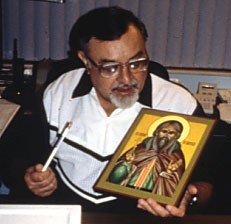Alexander J. Jasiukowicz
2001 Florida Folk Heritage Award

Orthodox iconography originated during the Byzantine Empire, probably in the fifth or sixth century AD. Like today, iconographic works included wall paintings, portable icons, mosaics, and painted manuscripts. During the eighth and ninth centuries a controversy erupted as to whether icons constituted idolatry, but the Church approved the continued usage of icons because they were considered symbols rather than physical representations. As a result of the controversy, strict rules regarding representation and symbology were established. The fall of Constantinople in 1453 was followed by the development of several national styles, and the integration of Western artistic elements and styles. In recent decades artists have rediscovered the Byzantine artistic heritage.
Alexander J. Jasiukowicz was born in Belarus of American parents. He developed an early interest in art and especially in Russian iconography, which he studied in Belarus at the Minsk Fine Arts Academy and later at the Warsaw Theological Seminary. While studying at St. Sergius Theological Institute in Paris, he took weekend classes with master iconographer Leonid Ouspensky, an important figure in the post-war movement that advocated a return to the older forms of Orthodox iconography. Although the movement met with initial resistance, by the 1950s it had gained enough strength that most American Orthodox parishes were commissioning paintings and mosaics in the older styles.
Jasiukowicz settled in Chicago in 1962, then moved to the Orlando area in 1982 with his wife and three sons. Ordained as an Orthodox priest in 1972, he has served parishes in Chicago and central Florida. Jasiukowicz finds that his training in the priesthood facilitates his understanding and interpretation of icons. He paints in the style of the Novgorodian School of the fifteenth century. Some critics describe this style as employing a joyful and almost folkloric approach to color and form. Jasiukowicz’ icons, which he considers “heavenly windows,” appear in about 30 Orthodox and Roman Catholic churches.
In addition to painting individual icons, Jasiukowicz often spends long periods in locations throughout the nation to create an entire church full of icons and murals. He adheres closely to the traditional rules of iconography, and see it as a godly task to be approached with humility and prayer. “[Iconographers] listened, read, and contemplated the Word of God. Their focus was set on things of the invisible, eternal world. . . . An iconographer recognized his God-given gift and glorified God with it. He detached himself from pride and became an empty vessel. This is why his icons were never signed.”
Jasiukowicz considers education a critical part of’ his mission. He has lectured at schools and universities, appeared on radio and television programs, written numerous articles for Orthodox and Roman Catholic publications, and exhibited his work in Chicago and Florida. He created the Orthodox Liturgical Arts Association to conduct research and produce educational materials on the iconographic discipline. He produced seven videos that explore the icon’s historical background, form, language, theological meaning, and aesthetic value. He also has taught students how to create icons—both independently and through the Florida Folklife Apprenticeship Program.

